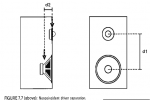Here's kuncher's video on this. He mentions the calculations for time delays and frequency.
He starts off by explaining that time delays affect timbre and makes a very interesting comparison of the frequency spectrum between a piano sounds played forwards then backwards to demonstrate frequency spectrum doesn't show this differences.
1. Time delay affects timbre
The popular example with the offset of tweeter and woofer (or woofer and mid-woofer).
 Source: Loudspeaker Design Book, Vance Dickason
Source: Loudspeaker Design Book, Vance Dickason
The offset should be in 99% of cases in the range 0.01 - 0.05m for tweeter and mid-woofer.
With 3-way speakers, the offset of woofer and midrange driver may be 0.1m.
If we take the maximum offset of 0.1m for woofer and midrange, then we get a time delay of about 0.1:344 = 0.3ms between the two drivers.
Keep these two values (
0.1m offset or 0.3ms delay) in mind, we will need them later.
From Prof. Kunchur's video I have now recorded and analyzed the example (C) with the two tones at 440Hz and 880Hz with delay.

To do this, I plot the impulse response for the left channel in Arta (by importing the recorded .wav file).
We can tell when the first tone starts, the time at which the second tone is added, and determine from the wavelength that the frequency of the first tone is 440Hz.
If we look at the end of the impulse response, only the 880Hz tone is still playing (obviously because of the delay).

Now we have to remember the two values from above. For a realistic scenario for playing the 440Hz and 880Hz tones, the delay should be around 0.3ms which corresponds to an offset of woofer and midrange by about 0.1m.
Then let's have a look at the delay value Prof. Kunchur has chosen for his demonstration:
The chosen time delay is completely insane and amounts to 5m. This means that the woofer of a loudspeaker would have to be five meters (196'') behind the midrange driver to have the effect shown in Prof. Kunchur's demonstration.
Why didn't he take a realistic value? Everyone is likely to know the answer. It is disgusting with which means inexperienced consumers are deceived.
2. frequency spectrum doesn't show this differences
This is misleading again, there is no gotcha! The recorded impulse response of a measurement contains the (amplitude) frequency and phase frequency response. Only both together (FR and Phase response) correspond to the impulse response.
If the impulse response is inverted, the frequency response does not change, that is correct, but the phase frequency response does. The example is trivial and shows nothing relevant for loudspeakers.
When measuring loudspeakers, the phase frequency response is usually not shown, because only a few people can do something with it*** and the information is not decisive for the sound of reasonably designed loudspeakers. For example, you can often determine the filter slope order and the crossover frequency from the phase frequency response.
Here is an example of an ideal speaker (FR + Phase) with normally connected drivers and both drivers connected with reverse polarity.
The FR does not change, but the phase frequency response does.


UPDATE***: An example of what information the
phase frequency response contains can be found here.







